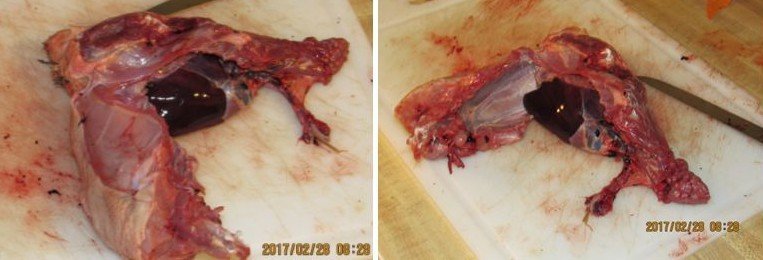processing / parting a chicken
2017-02-28
WARNING for blood-sensitive people:
This page shows pictures of butchering an animal. Do not proceed to look at the pictures if that makes you uncomfortable.
This article shows how to part a bird, any bird, from start to finish. Different species may look different on the outside, their bits and pieces may be differently sized or proportioned, but everything is there all the same.
These were 5 adult roosters that someone gifted me for slaughter. They're too tough for rotisserie but they make an excellent stew. See Coq au Vin. Take notice that the meat of these active backyard animals is dark red, nothing like the factory-farm chickens that hardly get any movement at all.
The main concern in processing an animal is to avoid perforating the intestines because the feces will contaminate and poison the meat. I find my method a lot easier and safer than the more commonly used method of slitting the belly and digging for the internal organs in a whole animal. But then, I don't care about roasting these whole, because they're going to be stewed.
Directions (rooster)
Chicken roosters are longer legged and overall skinnier than the plumper chicken hens.
No white meat like factory-farmed hens. Because backyard roosters are very active animals, their meat is 100% dark red, which makes them good substitutes for wild birds like pheasant or quail.
 Pic1: five roosters from the start ...
Pic1: five roosters from the start ...Pic2: ... to the middle ...
Pic3: ... to the finish
A. Head and neck skin: for stuffed neck.

Do this only if you want to keep the head and neck skin to stuff it. (Pic3)
If not, cut off the head and cut off the neck close to the body.
- Pic1: Cut the neck skin close to the body.
- Pic2: Roll up the skin towards the head and cut the neck at the head.
- Pic3: Roasted duck neck stuffed with sausage / ground meat / foie gras. (internet picture)
B. Neck, feet, wingtips, legs.

- Pic4: Remove neck, feet and wingtips. Cut around the joint; pull to dislocate and cut through joint.
I use the feet and wingtips to make soup. - Pic5: Cut through the skin between body and leg. Pull away to dislocate the hip.
- Pic6: Cut through the muscle and joint as close to the pelvis as possible. Do both sides.
C. Wings.

- Pic7: Cut along the midline, just to the side of the spine. Follow through along the ribs and go underneath the shoulder blade.
- Pic8: Pull away to dislocate the shoulder joint. Cut through muscle and joint to separate. Do both sides.
D. Separate the breast from the back.

- Pic9+10:
Starting at the neck, pull the breast bone away from the spine. That is usually quite easy. If the ribs don't break spontaneously, carefully cut the ribs along the edge of the breastbone. Separate the breast bone completely. If desired, cut the breast meat from the breastbone.
E. Remove the internal organs.

- Pic11: the back bone with all internal organs untouched.
- Pic12: Carefully pull away the organs from the spine, starting at the neck and fold them away from the tail. The lungs are protected by the spine and might not come away that easily. In ducks, they are hidden behind a tough membrane. Get them away from the spine by pushing your thumb upwards behind the lungs.
- Pic13: Cut off the entire tail without cutting through the intestine. That also removes the fat gland on the tail. (tastes bad, especially in water birds)
F. Finishing up.

- Pic14: Heart, liver and stomach are edible. Cut away the entire gall bladder from underneath the liver without damaging it. If you leak bile on the liver, toss that liver.
- Pic15: The testes (high up behind the stomach) are considered a restaurant delicacy. In an adult hen, you may find several developing eggs instead.
- Pic16: Two roosters, parted, washed and ready to be bagged for the freezer.